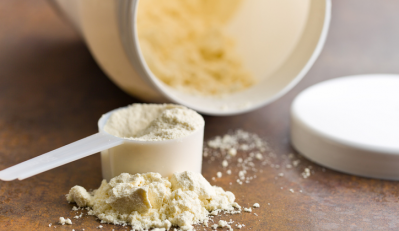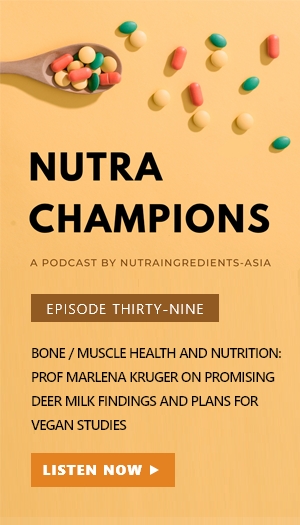Sarcopenic patients have low levels of NAD+ precursor trigonelline – Nestle-funded study

The research, published in Nature Metabolism, also found that trigonelline is a precursor of nicotinamide adenine dinucleotide (NAD+).
Nicotinamide mononucleotide (NMN) and nicotinamide riboside (NR) are some of the other well-known precursors of NAD+ and are increasingly consumed as supplements to increase NAD+ levels.
In the same vein, the researchers see nutritional supplementation of trigonelline as an NAD+-boosting strategy, with therapeutic potential for age-associated muscle decline.
“Our targeted metabolomic profiling of human sarcopenia revealed trigonelline as a new metabolite associated with muscle function, mitochondrial metabolism and NAD+,” they said.
This builds on the researchers’ previous findings on how low NAD+ levels are linked to sarcopenia.
While NR is a form of vitamin B3 and NMN synthesised from vitamin B3, trigonelline is a natural alkaloid found in animals and plants, such as coffee beans and fenugreek seeds.
The above findings are based on pre-clinical Caenorhabditis elegans experiment, mice study, a Singapore cohort study, and a replication study from an Iran cohort.
Human cohort studies findings
Using metabolomic profiling, the cohort study found that serum trigonelline levels are lower in sarcopenia and correlate positively with muscle strength, gait speed, as well as NAD+ levels and mitochondrial oxidative phosphorylation in skeletal muscle.
Mitochondrial oxidative phosphorylation is said to be the final biochemical pathway in the production of ATP. Reduced ATP production has been established as one of the drivers of muscle ageing.
The Singapore cohort study, which is part of a larger MEMOSA study taking place in Hertfordshire UK and Jamaica, involved 20 Chinese men aged 65 to 79 with a diagnosis of sarcopenia and another 20 healthy age-matched controls.
In the study, the researchers investigated the serum levels of vitamin B and kynurenine – a metabolite of the amino acid tryptophan in individuals with sarcopenia – versus that of healthy controls.
They found that patients with sarcopenia had lower circulating concentrations of trigonelline.
Higher levels of trigonelline were positively correlated with muscle mass, based on the Appendicular Lean Mass Index (ALMI) measured using dual-energy X-ray absorptiometry (DXA), grip strength and gait speed – which are all parameters used in the clinical definition of sarcopenia.
In addition, higher serum levels of trigonelline were found to associated with higher NAD+ levels in skeletal muscle.
Similar findings were also seen in an independent replication study from Iran involving 186 men aged 60 and above, which demonstrated that serum trigonelline is associated with muscle function.
Based on these findings, the researchers went on to treat both sarcopenic and healthy muscle cells with trigonelline and found that doing so had raised cellular NAD+ levels in both groups.
In animal models, NAD+ levels were also found to have increased when skeletal muscles from aged mice were treated with trigonelline.
What foods to supplement?
Although trigonelline could be found in coffee beans and fenugreek seeds, the researchers said that serum trigonelline levels were independent of dietary caffeine and vitamin B3 intake, as seen from the Iran cohort study.
Increasing dietary caffeine and vitamin B3 intake also did not affect the association between trigonelline and muscle strength among the Iranian participants.
“Although high coffee consumption has been associated with a lower prevalence of sarcopenia in some populations, our correlation analyses did not detect an association between circulating trigonelline and dietary caffeine intake levels in a population from the Middle East, possibly because coffee consumption is low in this population…
“It is also unlikely that intake of coffee and niacin directly drives the link between trigonelline and sarcopenia as the association of serum trigonelline with muscle function was not markedly influenced by correction of dietary caffeine and vitamin B3 intake,” said the researchers.
Serum trigonelline levels, however, could possibly be linked to other dietary factors, such as folate and fibre intake, as well as via a complex crosstalk between different food groups and endogenous metabolism.
“Interestingly, food may still contribute to trigonelline metabolism as the dietary intake of folate and fibre was linked to circulating trigonelline levels.
“In addition, trigonelline can be produced by the microbiome. Trigonelline was proposed as a biomarker of metabolic health or physical fitness because urinary trigonelline levels decrease during obesity and increase in professional athletes,” said the researchers.
Source: Nature Metabolism
Trigonelline is an NAD+ precursor that improves muscle function during ageing and is reduced in human sarcopenia.
https://doi.org/10.1038/s42255-024-00997-x
Authors: Membrez, M., Migliavacca, E., Christen, S. et al.



















